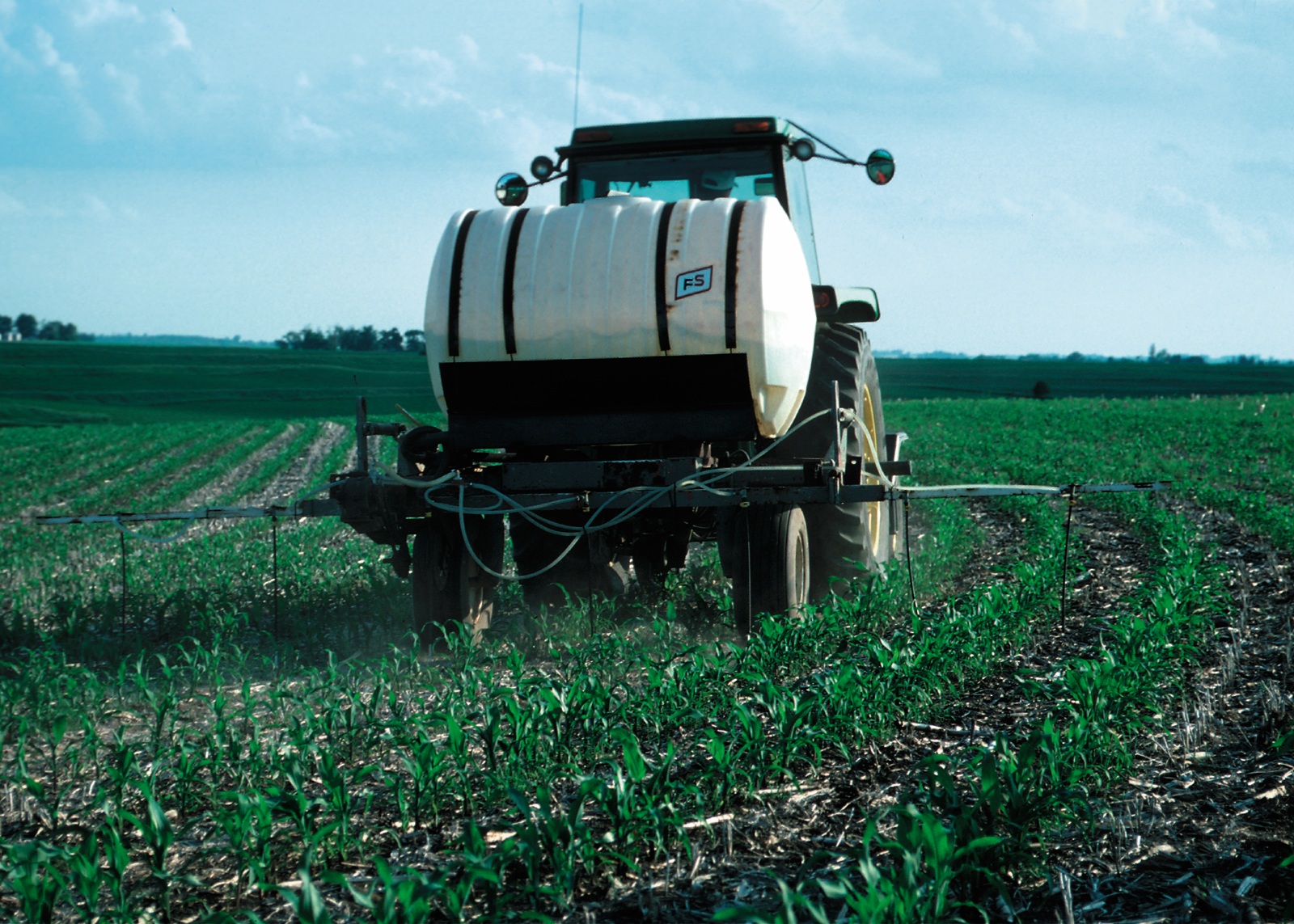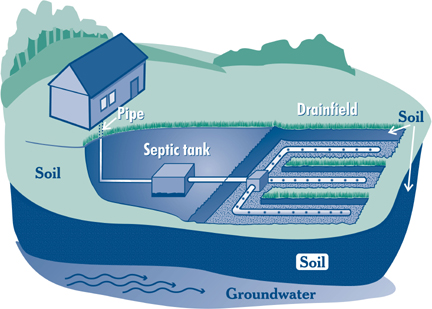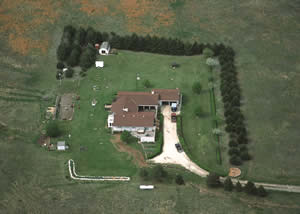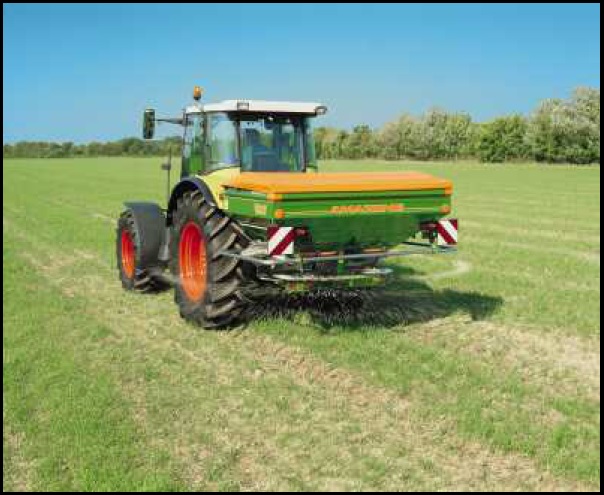-
Download:
My Results |
All BMPs
Septic Management
Category: Septic
Practice Type: Management
Climatic Zones: Temperate
Regions: North America
Pollutants Treated: Nitrogen, Phosphorus, Sediment
N Efficiency1: 5%
Description: Proper management of septic systems and drainfields can reduce risk of leaks and oversaturation which can lead to nitrogen losses. Septic tanks should be pumped once every three to five years to maintain effectiveness and avoid system failures. Septic pumping removes sewage, increasing the systems' capacity to remove settable and floatable solids from wastewater. In addition, vegetated cover should be maintained over the drainfield, use of garbage disposals should be limited, and water volume should be minimized. 2
Implementation Considerations: The septic tank and drainfield should be sited away from surface waters. There must be a disposal site for septage that does not pose a risk to public health or environmental quality.
Scalable to small farms? No
1 "Documentation: Source Data, BMP Effectiveness Values." Chesapeake Assessment Scenario Tool. Web. 2013. http://casttool.org/Documentation.aspx .
2 Estimates of County-level Nitrogen and Phosphorus Data for Use in Modeling Pollutant Reduction Documentation for Scenario Builder Version 2.2." Chesapeake Bay. Dec. 2010. Web. May 2013. http://archive.chesapeakebay.net/pubs/SB_V22_Final_12_31_2010.pdf.
Practice Type: Management
Climatic Zones: Temperate
Regions: North America
Pollutants Treated: Nitrogen, Phosphorus, Sediment
N Efficiency1: 5%
Description: Proper management of septic systems and drainfields can reduce risk of leaks and oversaturation which can lead to nitrogen losses. Septic tanks should be pumped once every three to five years to maintain effectiveness and avoid system failures. Septic pumping removes sewage, increasing the systems' capacity to remove settable and floatable solids from wastewater. In addition, vegetated cover should be maintained over the drainfield, use of garbage disposals should be limited, and water volume should be minimized. 2
Implementation Considerations: The septic tank and drainfield should be sited away from surface waters. There must be a disposal site for septage that does not pose a risk to public health or environmental quality.
Scalable to small farms? No
1 "Documentation: Source Data, BMP Effectiveness Values." Chesapeake Assessment Scenario Tool. Web. 2013. http://casttool.org/Documentation.aspx .
2 Estimates of County-level Nitrogen and Phosphorus Data for Use in Modeling Pollutant Reduction Documentation for Scenario Builder Version 2.2." Chesapeake Bay. Dec. 2010. Web. May 2013. http://archive.chesapeakebay.net/pubs/SB_V22_Final_12_31_2010.pdf.
Shelterbelts
Category: Erosion Control, Conservation Buffers
Practice Type: Structural, Management
Landuse/Agriculture Type: Row Crop, Pasture, Animal Confinement
Climatic Zones: Temperate, Semiarid
Regions: North America, Africa, Asia
Pollutants Treated: Nitrogen, Phosphorus, Sediment
Description: A shelterbelt is a barrier of trees or shrubs in linear formations used to shelter agricultural fields, farmyards, or livestock facilities from soil erosion from wind. Shelterbelts decrease wind erosion for distances up to 20 times the height of the trees. 1
Implementation Considerations: For maximum wind erosion control, shelterbelt rows should be planted at a distance of less than 200 meters apart and across the prevailing wind direction. Tree or shrub rows should be oriented on or near the contour where water erosion is a concern.
Scalable to small farms? Yes
1 "Beneficial Management Practices: Environmental Manual for Crop Producers in Alberta." Alberta Agriculture and Rural Development. 2004. Web. Apr. 2014. http://www1.agric.gov.ab.ca/$department/deptdocs.nsf/all/agdex9483/$file/100_25-1.pdf?OpenElement.
Practice Type: Structural, Management
Landuse/Agriculture Type: Row Crop, Pasture, Animal Confinement
Climatic Zones: Temperate, Semiarid
Regions: North America, Africa, Asia
Pollutants Treated: Nitrogen, Phosphorus, Sediment
Description: A shelterbelt is a barrier of trees or shrubs in linear formations used to shelter agricultural fields, farmyards, or livestock facilities from soil erosion from wind. Shelterbelts decrease wind erosion for distances up to 20 times the height of the trees. 1
Implementation Considerations: For maximum wind erosion control, shelterbelt rows should be planted at a distance of less than 200 meters apart and across the prevailing wind direction. Tree or shrub rows should be oriented on or near the contour where water erosion is a concern.
Scalable to small farms? Yes
1 "Beneficial Management Practices: Environmental Manual for Crop Producers in Alberta." Alberta Agriculture and Rural Development. 2004. Web. Apr. 2014. http://www1.agric.gov.ab.ca/$department/deptdocs.nsf/all/agdex9483/$file/100_25-1.pdf?OpenElement.
Slow Release/Controlled Release Fertilizers
Category: Nutrient Management
Practice Type: Management
Landuse/Agriculture Type: Row Crop, Small Grains, Pasture, Fodder
Climatic Zones: Temperate, Semiarid, Tropical
Regions: North America
Pollutants Treated: Nitrogen
Description: Slow release fertilizers minimize the potential for nutrient losses to the environment by slowly converting the ammonium and/or nitrogen over time. Slow release fertilizers can extend N availability over a full growing season. N release is limited by temperature and moisture. Controlled release fertilizers are coated with a polymer or with sulfer. The coating delays the availability of the nutrients for plant uptake after application and controls nutrient release over time. Slow and controlled release fertilizers allow for better timing of N release to be more consistent with crop growth and N demands, reduce N losses from leaching, denitrification and/or volatilization, and can result in more uniform growth because of reduced risk of seedling burn or salt damage. 1
Implementation Considerations: Slow and controlled release fertilziers are more expensive per unit N and are not desirable when a quick release is needed, for example, when sidedressing corn.
Scalable to small farms? Yes
Scaling Considerations: Cost and availability may be limiting factors for application on small and disadvantaged farms.
1 "Enhanced-Efficiency Nitrogen Sources." Agronomy Fact Sheet Series; Fact Sheet 45. Cornell University Cooperative Extension, 2009. http://nmsp.cals.cornell.edu/publications/factsheets/factsheet45.pdf
Practice Type: Management
Landuse/Agriculture Type: Row Crop, Small Grains, Pasture, Fodder
Climatic Zones: Temperate, Semiarid, Tropical
Regions: North America
Pollutants Treated: Nitrogen
Description: Slow release fertilizers minimize the potential for nutrient losses to the environment by slowly converting the ammonium and/or nitrogen over time. Slow release fertilizers can extend N availability over a full growing season. N release is limited by temperature and moisture. Controlled release fertilizers are coated with a polymer or with sulfer. The coating delays the availability of the nutrients for plant uptake after application and controls nutrient release over time. Slow and controlled release fertilizers allow for better timing of N release to be more consistent with crop growth and N demands, reduce N losses from leaching, denitrification and/or volatilization, and can result in more uniform growth because of reduced risk of seedling burn or salt damage. 1
Implementation Considerations: Slow and controlled release fertilziers are more expensive per unit N and are not desirable when a quick release is needed, for example, when sidedressing corn.
Scalable to small farms? Yes
Scaling Considerations: Cost and availability may be limiting factors for application on small and disadvantaged farms.
1 "Enhanced-Efficiency Nitrogen Sources." Agronomy Fact Sheet Series; Fact Sheet 45. Cornell University Cooperative Extension, 2009. http://nmsp.cals.cornell.edu/publications/factsheets/factsheet45.pdf
Soil Testing
Category: Nutrient Management
Practice Type: Management
Landuse/Agriculture Type: Row Crop, Pasture, Fodder, Rice, Small Grains, Animal Confinement, Palm Oil
Climatic Zones: Temperate, Semiarid, Tropical
Regions: North America, South Asia, Europe
Pollutants Treated: Nitrogen, Phosphorus, Sediment
P Efficiency1: 0-25%
Description: Soil testing is used before planting to determine the characteristics of the soil, including nutrient content, pH, moisture, and composition. Soil testing is an important component for determining the right balance and right rate of nutrient application on the field. The soil testing process is based on soil samples being taken from representative areas in a field, analyzed using a chemical extraction appropriate for the soils in the region, and either correlated with plant nutrient uptake or calibrated with crop yield. Resulting fertilizer recommendations would be based on how a particular crop responded to a nutrient, using the average response from a multi-year and multi-site data set. 2
Implementation Considerations: Soil should be tested every 3-5 years. One sample should be taken for every 20 acres at a depth of approximately 8 inches. In the U.S. a soil test costs between $7 and $10 per sample. Applicability of this practice will depend on proximity to qualified soil testing laboratories and extension services.
Scalable to small farms? Yes
1 Wortman, Charles S. "Agricultural Phosphorus Management and Water Quality Protection in the Midwest." The Heartland Regional Water Coordination Initiative. University of California, Division of Agriculture and Natural Resources. Web. July 2014. http://extension.missouri.edu/explorepdf/regpubs/ncr187.pdf .
2 "Best Management Practices, Today's Agriculture: A Responsible Legacy." Nutrient Best Management Practices. Web. Aug. 2013. http://dda.delaware.gov/nutrients/D17762BestMgmtbklt.pdf .
Practice Type: Management
Landuse/Agriculture Type: Row Crop, Pasture, Fodder, Rice, Small Grains, Animal Confinement, Palm Oil
Climatic Zones: Temperate, Semiarid, Tropical
Regions: North America, South Asia, Europe
Pollutants Treated: Nitrogen, Phosphorus, Sediment
P Efficiency1: 0-25%
Description: Soil testing is used before planting to determine the characteristics of the soil, including nutrient content, pH, moisture, and composition. Soil testing is an important component for determining the right balance and right rate of nutrient application on the field. The soil testing process is based on soil samples being taken from representative areas in a field, analyzed using a chemical extraction appropriate for the soils in the region, and either correlated with plant nutrient uptake or calibrated with crop yield. Resulting fertilizer recommendations would be based on how a particular crop responded to a nutrient, using the average response from a multi-year and multi-site data set. 2
Implementation Considerations: Soil should be tested every 3-5 years. One sample should be taken for every 20 acres at a depth of approximately 8 inches. In the U.S. a soil test costs between $7 and $10 per sample. Applicability of this practice will depend on proximity to qualified soil testing laboratories and extension services.
Scalable to small farms? Yes
1 Wortman, Charles S. "Agricultural Phosphorus Management and Water Quality Protection in the Midwest." The Heartland Regional Water Coordination Initiative. University of California, Division of Agriculture and Natural Resources. Web. July 2014. http://extension.missouri.edu/explorepdf/regpubs/ncr187.pdf .
2 "Best Management Practices, Today's Agriculture: A Responsible Legacy." Nutrient Best Management Practices. Web. Aug. 2013. http://dda.delaware.gov/nutrients/D17762BestMgmtbklt.pdf .
Split Nitrogen Application (Sidedress Nitrogen Fertilizer Application)
 Nitrogen being applied to growing corn in a contoured, no-tilled field in Hardin County. Applying smaller amounts of nitrogen several times over the growing season rather than all at once at or before planting helps the plants use the nitrogen rather than have it enter water supplies. Photographer: Lynn Betts. Photo Courtesy of USDA NRCS.
Nitrogen being applied to growing corn in a contoured, no-tilled field in Hardin County. Applying smaller amounts of nitrogen several times over the growing season rather than all at once at or before planting helps the plants use the nitrogen rather than have it enter water supplies. Photographer: Lynn Betts. Photo Courtesy of USDA NRCS.
Practice Type: Management
Landuse/Agriculture Type: Row Crop
Climatic Zones: Temperate, Semiarid, Tropical
Regions: North America, South Asia, Europe
Pollutants Treated: Nitrogen
Description: In a split application fertilizer treatment, the total nitrogen fertilizer application is divided into two or more treatments can result in higher nutrient use efficiencies and reduced losses from denitrification, leaching and volatilization. By contrast, when a crop’s total nitrogen requirement is supplied with a single pre-plant or at-planting application, most of the N must “wait” for the target crop’s future needs and that means the window for potential loss remains open longer. In a split application treatment, the first application of fertilizer is generally applied at planting or prior to planting with the second application applied after the crop has germinated (sidedress application). Generally the sidedress application is an application of either anhydrous ammonia or urea ammonium nitrate that is either sprayed or injected.
Implementation Considerations: Requires more time/passes over the field as compared to a single application. The sidedress application can interfere with other crop management activities or may be difficult as a result of field wetness.
Scalable to small farms? Yes
Scaling Considerations: See FAO publicaiton on fertilzer application methods: ftp://ftp.fao.org/agl/agll/docs/fertuse.pdf Some type of split fertilizer application regime should be applicable to small farmers, based on understanding of crop needs.



